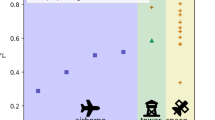Summary
Sudden illumination of sunflower (Helianthus annuus L. cv. CGL 208) leaves and canopies led to excess absorbed PFD and induced apparent reflectance changes in the green, red and near-infrared detectable with a remote spectroradiometer. The green shift, centered near 531 nm, was caused by reflectance changes associated with the de-epoxidation of violaxanthin to zeaxanthin via antheraxanthin and with the chloroplast thylakoid pH gradient. The red (685 nm) and near-infrared (738 nm) signals were due to quenching of chlorophyll fluorescence. Remote sensing of shifts in these spectral regions provides non-destructive information on in situ photosynthetic performance and could lead to improved techniques for remote sensing of canopy photosynthesis.
Similar content being viewed by others
References
Bilger W, Björkman O, Thayer SS (1989) Light-induced spectral absorbance changes in relation to photosynthesis and the epoxidation state of xanthophyll cycle components in cotton leaves. Plant Physiol 91:542–551
Bolhar-Nordenkampf HR, Long SP, Baker NR, Oquist G, Schreiber U, Lechner EG (1989) Chlorophyll fluorescence as a probe of the photosynthetic competence of leaves in the field: a review of current instrumentation. Funct Ecol 3:497–514
Chappelle EW, Wood FM Jr., Newcomb WW, McMurtey JE III (1985) Laser-induced fluorescence of green plants. 3: LIF spectral signatures of five major plant types. Appl Opt 24(1):74–80
Choudhury BJ (1987) Relationships between vegetation indices, radiation absorption, and net photosynthesis evaluated by a sensitivity analysis. Remote Sensing Environ 22:209–233
Demmig-Adams B, Winter K, Krüger A, Czygan F-C (1989) Light stress and photoprotection related to the carotenoid zeaxanthin in higher plants. In: Briggs WR (ed) Photosynthesis. Alan R. Liss, Inc. New York, pp 375–391
Goel NS (1988) Models of vegetation canopy reflectance and their use in estimation of biophysical parameters from reflectance data. Remote Sensing Rev 4:1–212
Goward SN, Tucker CJ, Dye DG (1985) North American vegetation patterns observed with the NOAA-7 advanced very high resolution radiometer. Vegetatio 64:3–14
Hager A (1980) The reversible, light-induced conversions of xanthophylls in the chloroplast. In: Czygan F-C (ed) Pigments in Plants, Ed 2. Fischer, Stuttgart, pp 57–79
Heber U (1969) Conformation changes of chloroplasts induced by illumination of leaves in vivo. Biochim Biophys Acta 180:302–319
Krause GH, Vernotte C, Briantais JM (1982) Photoinduced quenching of chlorophyll fluorescence in intact chloroplasts and algae. Resolution into two components. Biochim Biophys Acta 679:116–124
Running SR, Nemani RR (1988) Relating seasonal patterns of the AVHRR vegetation index to simulated photosynthesis and transpiration of forests in different climates. Remote Sensing Environ 24:347–367
Schreiber U, Bilger W (1987) Rapid assessment of stress effects on plant leaves by chlorophyll fluorescence measurements. In: Tenhunen JD, Catarino FM, Lange OL, Oechel WC (eds) Plant Responses to Stress. Functional Analysis in Mediterranean Ecosystems. NATO ASI Series G: Ecological Sciences Vol 15. Springer, Berlin Heidelberg New York, pp 27–53
Schreiber U, Schliwa U, Bilger W (1986) Continuous recording of photochemical and non-photochemical fluorescence quenching with a new type of modulation fluorometer. Photosynth Res 10:51–62
Seemann JR (1986) Mechanism for the regulation of CO2 fixation by Ribulose-1,5-bisphosphate carboxylase. In: Marcelle R, Clijsters H, Van Poucke M (eds) Biological Control of Photosynthesis. Martinus Nijhoff, Dordrecht pp 71–82
Sellers PJ (1985) Canopy reflectance, photosynthesis and transpiration. Int J Remote Sens 6:1335–1372
Sellers PJ (1987) Canopy reflectance, photosynthesis, and transpiration. II. The role of biophysics in the linearity of their interdependence. Remote Sensing Environ 21:143–183
Thayer SS, Björkman O (1990) Leaf xanthophyll content and composition in sun and shade determined by HPLC. Photosynth Res 23:331–343
Virgin HI (1954) The distortion of fluorescence spectra in leaves by light scattering and its reduction by infiltration. Physiol Plant 7:560–570
Weidner VR, Hsia JJ (1981) Reflection properties of pressed polytetrafluoroethylene powder. J Opt Soc Am 71(7):856–861
Yamamoto HY (1979) Biochemistry of the violaxanthin cycle in higher plants. Pure Appl Chem 51:639–648
Yamamoto HY, Kamite L (1972) The effects of dithiothreitol on violaxanthin de-epoxidation and absorbance changes in the 500-nm region. Biochim Biophys Acta 267:538–543
Author information
Authors and Affiliations
Additional information
CIW Publication #1072
Rights and permissions
About this article
Cite this article
Gamon, J.A., Field, C.B., Bilger, W. et al. Remote sensing of the xanthophyll cycle and chlorophyll fluorescence in sunflower leaves and canopies. Oecologia 85, 1–7 (1990). https://doi.org/10.1007/BF00317336
Received:
Accepted:
Issue Date:
DOI: https://doi.org/10.1007/BF00317336




